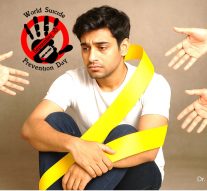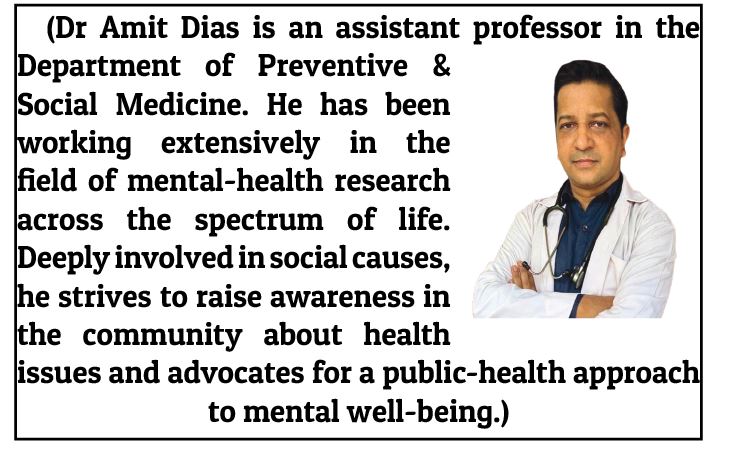Goa is abuzz with excitement as vintage bike and car owners, users, collectors and fans are decking […]

SHINING A LIGHT ON SUICIDE LEARN HOW YOU CAN SAVE LIVES! By Dr Amit Dias, MD
MIND & BODY, HEART & SOUL, Sep 13- Sep 19, 2025 September 12, 2025Every year September 10 is observed as World Suicide Prevention Day, and the theme this year focuses on “Changing the Narrative on Suicide.” In light of the recent tragedies where young lives have been lost to suicide, it becomes imperative that we, as a society, address it. Suicide is not just a personal crisis — it is a public-health emergency that demands urgent and collective action. This week, Dr Amit Dias not only urges us to address the elephant in the room, but also offers practical solutions and a step-by-step approach to prevention. This is not just an article to read — it is a skill you all should LEARN.
The elephant in the room:
EVERY year, the headlines remind us of a tragedy we collectively fail to address — young lives lost to suicide. As a nation, we are losing some of our brightest minds, often at an age when life should be opening up with promise and possibility. Suicide has now become one of the leading causes of death among young people in India. According to the National Crime Records Bureau (ADSI 2022), around 1.7 lakh people died by suicide in 2022, the highest number reported so far, with students alone accounting for more than 13,000 deaths. These figures are not just numbers — they represent futures lost, families devastated, and a society in urgent need of action. We can no longer ignore this elephant in the room.
Suicide is not a private matter — it is a public-health emergency
I remember I was once asked to speak on mental health at a function and I was denied the permission stating that it is the job of a psychiatrist and not preventive medicine or public health. This is the very mindset that is flawed. Mental health is not just a public health problem — it’s a public health emergency.
For too long, we have treated suicide for example, as a matter of shame, silence, or individual weakness. But it is not just a private tragedy; it is a public-health emergency. This is not merely restricted to a campus, it’s not restricted to one professional college — it is a policy issue that demands a collective response. We cannot continue to ignore the elephant in the room. Mental health must be seen, acknowledged, and addressed through coordinated action across families, schools, workplaces, healthcare systems, and government policy.
Recognising the signs — and why it matters…
Most people who think about suicide show warning signs, and recognising these early can save lives. Some of these include:
Talking about hopelessness, death, or feeling like a burden.
Withdrawing from friends, family or usual activities.
Dramatic mood changes, from sadness to sudden calm.
Changes in sleep, appetite, or academic/work performance.
Increased use of alcohol or drugs, or engaging in risky behaviour.
Giving away possessions or making “final” plans.
When we notice these signs, silence is dangerous. If we notice someone writing his sorrow on social media and claiming to end his life, do not ignore him or her, your simple phone call can make a difference. We must LEARN how to reach out and act.

‘LEARN’ to approach someone in distress
It can feel difficult to talk to someone about suicide, but a simple step as first aid can save a life.
L — Listen without judgement. Give your time and presence.
E — Empathize and express concern. Let them know you care.
A — Ask directly about suicide. Don’t be afraid to say, “Are you thinking about ending your life?”
R — Reduce immediate risk and Reassure. Ensure they are not left alone and remove access to harmful means where possible- example pesticide, ropes, sharp things, etc.
N — Navigate to support. Help connect them to professional help, crisis services, or trusted family members.
Remember, asking about suicide does not “put the idea” in someone’s head — it opens a door for them to share their pain. By talking we can change the narrative and help them see a new light.
A step-by-step approach to prevention
S – Support emotional wellbeing- create happy spaces in schools, work and at home.
U – Understand the warning signs and pick them early.
I – Intervene early, start a conversation using the LEARN approach mentioned above.
C – Connect with professional help— use helplines, mental-health services, or hospital emergency care if needed.
I – Involve family and friends – Create a safety plan with coping strategies, emergency contacts, and follow-ups.
D – Destigmatise mental health
E – Encourage HOPE – Stay connected — regular support can make a big difference.
At a broader level, schools, workplaces, and policymakers must also step in. Training teachers and peers as “gatekeepers,” ensuring counselling services, building non-judgemental therapy spaces, and promoting responsible media reporting are all crucial. There has to be regular sensitisation programs for leaders in various institutes, if they are motivated they will find ways to build a safety net within their own institution. However, most often they are blinded to the fact that this can happen and take knee jerk action only when the damage is done.
Changing the narrative — together…
The narrative around suicide must shift. Mental health is not a matter of private shame; it is a shared responsibility. We must replace stigma with empathy, silence with open conversations, and isolation with systems of support. Our young people deserve spaces where they feel welcome, understood and safe to seek help.
If you or someone you know is struggling, please remember — help is available. In India, you can dial Tele-MANAS: 14416 / 1800-891-4416 for 24/7 support. Reaching out is not a sign of weakness — it is a step towards life.
















